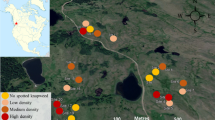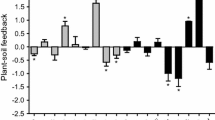Abstract
One of the greatest challenges in contemporary ecology is to understand how the homogenization of biodiversity at all levels of organization and spatial scales will influence the assembly of communities and the functioning of ecosystems. Such homogenization can occur through the gain of non-native species and the loss of native species. Here, we show that by disrupting a keystone mutualistic interaction, non-native ungulates indirectly impact foliar arthropod abundance and richness, but not soil properties (soil respiration, temperature and humidity), in a temperate forest of Patagonia. The results of this study show that the gain of non-native ungulates and the loss of a key interaction can trigger unnoticed cascading effects. Our findings highlight the importance of assessing biodiversity not only as the sum of different components but also through the direct and indirect interactions among them.



Similar content being viewed by others
References
Aizen MA (2003) The relative influence of animal pollination and seed dispersal on flowering time in a winter flowering mistletoe. Ecology 84:2613–2627
Aizen MA, Ezcurra C (1998) High incidence of plant-animal mutualisms in the woody flora of the temperate forest of southern South America: biogeographical origin and present ecological significance. Ecol Austral 8:217–236
Allison SD (2006) Brown ground: a soil carbon analogue for the green world hypothesis? Am Nat 167:619–627
Amico GC, Aizen MA (2000) Ecology: mistletoe seed dispersal by a marsupial. Nature 408:929
Amico GC, Rodriguez-Cabal MA, Aizen MA (2009) The potential key seed-dispersing role of the arboreal marsupial Dromiciops gliroides. Acta Oecol 35:8–13
Armesto J, Rozzi R (1989) Seed dispersal syndromes in the rain forest of Chiloé: evidence for the importance of biotic dispersal in a temperate rain forest. J Biogeogr 16(3):219–226
Bailey JK, Whitham TG (2002) Interactions among fire, aspen, and elk affect insect diversity: reversal of a community response. Ecology 83:1701–1712
Bardgett RD, Wardle DA (2010) Aboveground-belowground linkages: biotic interactions, ecosystem processes, and global change. Oxford University Press, Oxford
Barrios-Garcia MN, Relva MA, Kitzberger T (2012) Patterns of use and damage by exotic deer on native plant communities in northwestern Patagonia. Eur J Wildl Res 58:137–146
Borer ET, Halpern BS, Seabloom EW (2006) Asymmetry in community regulation: effects of predators and productivity. Ecology 87:2813–2820
Cabrera LA (1976) Regiones Fitogeográficas Argentinas. ACME, Buenos Aires
Cavieres LA, Badano EI (2009) Do facilitative interactions increase species richness at the entire community level? J Ecol 97:1181–1191
Chen D, Zheng S, Shan Y, Taube F, Bai Y (2013) Vertebrate herbivore-induced changes in plants and soils: linkages to ecosystem functioning in a semi-arid steppe. Funct Ecol 27:273–281
Clarke KR (1993) Non-parametric multivariate analyses of changes in community structure. Austral Ecol 18:117–143
Clarke K, Gorley R (2006) PRIMER, v6: user manual/tutorial. PRIMER-E, Plymouth
Cornelissen JS, Lavorel E, Garnier Diaz S, Buchmann N, Gurvich D, Reich P, Ter Steege H, Morgan H, Van Der Heijden M (2003) A handbook of protocols for standardised and easy measurement of plant functional traits worldwide. Aust J Bot 51:335–380
Côté SD, Rooney TP, Tremblay JP, Dussault C, Waller DM (2004) Ecological impacts of deer overabundance. Annu Rev Ecol Evol Syst 35:113–147
Crawley MJ (1986) The population biology of invaders. Philos Trans R Soc Lond B 314:711–731
Crooks KR, Soulé ME (1999) Mesopredator release and avifaunal extinctions in a fragmented system. Nature 400:563
Cuevas-Reyes P, Pérez-López G, Maldonado-López Y, González-Rodríguez A (2017) Effects of herbivory and mistletoe infection by Psittacanthus calyculatus on nutritional quality and chemical defense of Quercus deserticola along Mexican forest fragments. Plant Ecol 218:687–697
Danell K, Huss-Danell K (1985) Feeding by insects and hares on birches earlier affected by moose browsing. Oikos 44:75–81
Estes JA, Terborgh J, Brashares JS, Power ME, Berger J, Bond WJ, Carpenter SR, Essington TE, Holt RD, Jackson JB (2011) Trophic downgrading of planet Earth. Science 333:301–306
Findlay S, Carreiro M, Krischik V, Jones CG (1996) Effects of damage to living plants on leaf litter quality. Ecol Appl 6:269–275
Fukami T, Wardle DA, Bellingham PJ, Mulder CPH, Towns DR, Yeates GW, Bonner KI, Durrett MS, Grant-Hoffman MA, Williamson WM (2006) Above- and below-ground impacts of introduced predators in seabird-dominated island ecosystems. Ecol Lett 9:1299–1307
Gill RMA (1992) A review of damage by mammals in north temperate forest: 3. Impact on trees and forests. Forestry 65:363–388
Gish M, Ben-Ari M, Inbar M (2017) Direct consumptive interactions between mammalian herbivores and plant-dwelling invertebrates: prevalence, significance, and prospectus. Oecologia 183:347–352
Gross K (2008) Positive interactions among competitors can produce species-rich communities. Ecol Lett 11:929–936
Holt RD (1977) Predation, apparent competition, and the structure of prey communities. Theor Popul Biol 12:197–229
Jacksic F, Iriarte JA, Jimenez JA, Martinez DR (2002) Invaders without frontiers: cross-border invasions of exotic mammals. Biol Invasions 4:157–173
Karban R, Baldwin IT (1997) Induced responses to herbivory. University of Chicago Press, Chicago
Kaspari M, Yanoviak SP (2009) Biogeochemistry and the structure of tropical brown food webs. Ecology 90:3342–3351
Mack MC, D’Antonio CM (1998) Impacts of biological invasions on disturbance regimes. Trends Ecol Evol 13:195–198
Martinsen GD, Driebe EM, Whitham TG (1998) Indirect interactions mediated by changing plant chemistry: beaver browsing benefits beetles. Ecology 79:192–200
McNaughton S (1983) Compensatory plant growth as a response to herbivory. Oikos 40:329–336
Mooney HA (2010) The ecosystem-service chain and the biological diversity crisis. Philos Trans R Soc Lond B Biol Sci 365:31–39
Moore JC, Berlow EL, Coleman DC, Ruiter PC, Dong Q, Hastings A, Johnson NC, McCann KS, Melville K, Morin PD (2004) Detritus, trophic dynamics and biodiversity. Ecol Lett 7:584–600
Nuñez MA, Bailey JK, Schweitzer JA (2010) Population, community and ecosystem effects of exotic herbivores: a growing global concern. Biol Invasions 12:297–301
Nuttle T, Yerger EH, Stoleson SH, Ristau TE (2011) Legacy of top-down herbivore pressure ricochets back up multiple trophic levels in forest canopies over 30 years. Ecosphere 2:1–11
Ohgushi T (2005) Indirect interaction webs: herbivore-induced effects through trait change in plants. Annu Rev Ecol Evol Syst 36:81–105
Pastor J, Dewey B, Naiman RJ, McInnes PF, Cohen Y (1993) Moose browsing and soil fertility in the boreal forests of Isle Royale National Park. Ecology 74:467–480
Peay KG, Schubert MG, Nguyen NH, Bruns TD (2012) Measuring ectomycorrhizal fungal dispersal: macroecological patterns driven by microscopic propagules. Mol Ecol 21:4122–4136
Persson IL, Nilsson MB, Pastor J, Eriksson T, Bergström R, Danell K (2009) Depression of belowground respiration rates at simulated high moose population densities in boreal forests. Ecology 90:2724–2733
Press MC, Phoenix GK (2005) Impacts of parasitic plants on natural communities. New Phytol 166:737–751
Pringle RM, Young TP, Rubenstein DI, McCauley DJ (2007) Herbivore-initiated interaction cascades and their modulation by productivity in an African savanna. Proc Natl Acad Sci 104:193–197
Quested HM, Cornelissen JHC, Press MC, Callaghan TV, Aerts R, Trosien F, Riemann P, Gwynn-Jones D, Kondratchuk A, Jonasson SE (2003) Decomposition of sub-arctic plants with differing nitrogen economies: a functional role for hemiparasites. Ecology 84:3209–3221
Rodriguez-Cabal MA, Barrios-Garcia MN, Amico GC, Aizen MA, Sanders NJ (2013) Node-by-node disassembly of a mutualistic interaction web driven by species introductions. Proc Natl Acad Sci 110:16503–16507
Schmitz OJ, Hambäck PA, Beckerman AP (2000) Trophic cascades in terrestrial systems: a review of the effects of carnivore removals on plants. Am Nat 155:141–153
Schöb C, Armas C, Guler M, Prieto I, Pugnaire FI (2013) Variability in functional traits mediates plant interactions along stress gradients. J Ecol 101:753–762
Shurin JB, Borer ET, Seabloom EW, Anderson K, Blanchette CA, Broitman B, Cooper SD, Halpern BS (2002) A cross-ecosystem comparison of the strength of trophic cascades. Ecol Lett 5:785–791
Stireman J, Dyer LA, Janzen DH, Singer M, Lill J, Marquis RJ, Ricklefs RE, Gentry G, Hallwachs W, Coley PD (2005) Climatic unpredictability and parasitism of caterpillars: implications of global warming. Proc Natl Acad Sci USA 102:17384–17387
Strauss SY (1991) Indirect effects in community ecology: their definition, study and importance. Trends Ecol Evol 6:206–210
Terborgh J, Lopez L, Nuñez P, Rao M, Shahabuddin G, Orihuela G, Riveros M, Ascanio R, Adler GH, Lambert TD (2001) Ecological meltdown in predator-free forest fragments. Science 294:1923–1926
Traveset A, Richardson DM (2006) Biological invasions as disruptors of plant reproductive mutualisms. Trends Ecol Evol 21:208–216
van der Putten W (2012) Climate change, aboveground-belowground interactions, and species range shifts. Annu Rev Ecol Evol Syst 43:365–383
van der Wal R, van Lieshout SM, Loonen MJ (2001) Herbivore impact on moss depth, soil temperature and arctic plant growth. Polar Biol 24:29–32
van Klink R, van der Plas F, Van Noordwijk C, WallisDeVries MF, Olff H (2015) Effects of large herbivores on grassland arthropod diversity. Biol Rev 90:347–366
Vanbergen AJ, Hails R, Watt A, Jones TH (2006) Consequences for host–parasitoid interactions of grazing-dependent habitat heterogeneity. J Anim Ecol 75:789–801
Vázquez DP (2002) Multiple effects of introduced mammalian herbivores in a temperate forest. Biol Invasions 4:175–191
Vázquez DP, Simberloff D (2004) Indirect effects of an introduced ungulate on pollination and plant reproduction. Ecol Monogr 74:281–308
Veblen TT, Mermoz M, Martin C, Ramilo E (1989) Effects of exotic deer on forest regeneration and composition in Northern Patagonia. J Appl Ecol 26:711–724
Veblen TT, Mermoz M, Martin C, Kitzberger T (1992) Ecological impacts of introduced animals in Nahuel Huapi Nationa Park, Argentina. Conserv Biol 6:71–83
Wardle DA, Bonner KI, Barker GM (2002) Linkages between plant litter decomposition, litter quality, and vegetation responses to herbivores. Funct Ecol 16:585–595
Wardle DA, Bardgett RD, Klironomos JN, Setala H, van der Putten WH, Wall DH (2004) Ecological linkages between aboveground and belowground biota. Science 304:1629–1633
White EM, Wilson JC, Clarke AR (2006) Biotic indirect effects: a neglected concept in invasion biology. Divers Distrib 12:43–455
Williamson M (1996) Biological invasions. Springer, Berlin
Wootton JT (1994) The nature and consequences of indirect effects. Annu Rev Ecol Syst 25:443–466
Acknowledgements
We thank staff of Nahuel Huapi National Park and Los Arrayanes National Park, D. Mujica and C. Chehebar for logistic support and permission to carry out fieldwork. We also thank the Editor and three anonymous reviewers for useful comments and suggestions. Special thanks go to Ezequiel Rodriguez-Cabal and Greg Crutsinger who made the drawings. This research was supported with a grant from “Agencia Nacional de Promoción Científica y Tecnológica” of Argentina (PICT 2014-2484) to MARC.
Author information
Authors and Affiliations
Corresponding author
Additional information
Publisher's Note
Springer Nature remains neutral with regard to jurisdictional claims in published maps and institutional affiliations.
Rights and permissions
About this article
Cite this article
Rodriguez-Cabal, M.A., Barrios-Garcia, M.N., Greyson-Gaito, C.J. et al. Non-native ungulates indirectly impact foliar arthropods but not soil function. Biol Invasions 21, 3077–3084 (2019). https://doi.org/10.1007/s10530-019-02030-9
Received:
Accepted:
Published:
Issue Date:
DOI: https://doi.org/10.1007/s10530-019-02030-9




